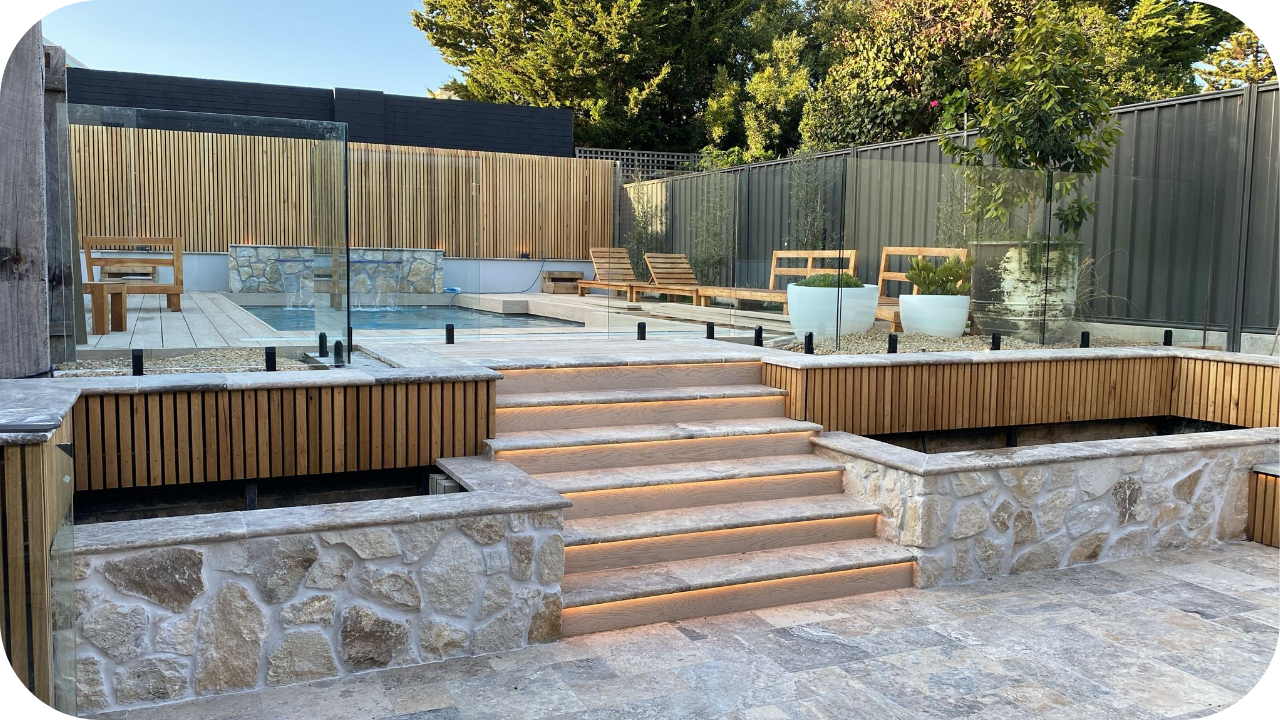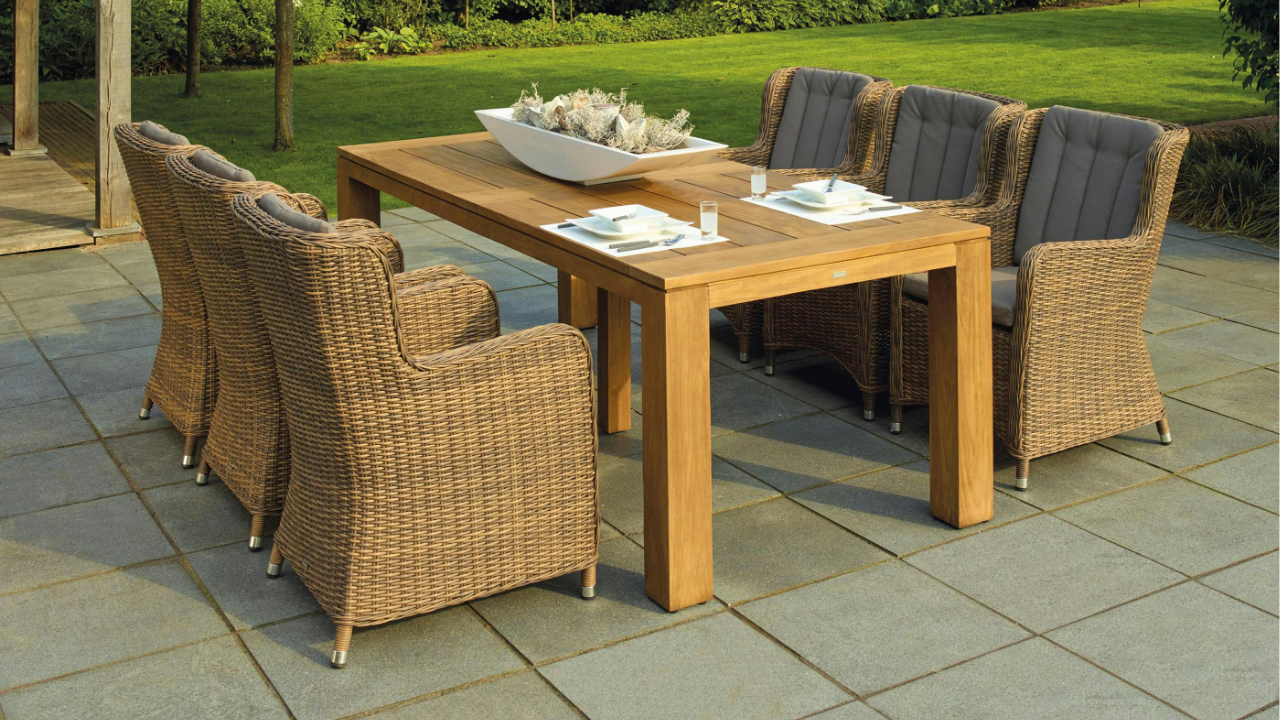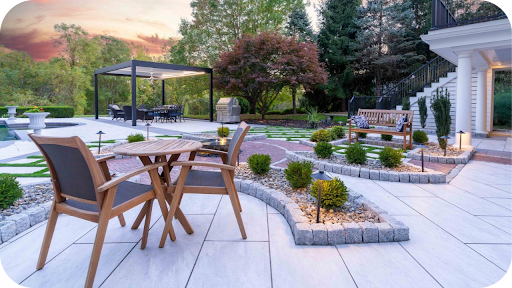
When it comes to creating the perfect pool area, safety and style go hand in hand. While the water may take centre stage, the surface that surrounds it plays a crucial role in both the look and function of your space.
The right stone can elevate your backyard into a resort-style retreat, especially when it stays cool underfoot and stands the test of time.
Here’s how to choose natural stone that’s as safe as it is stunning for your poolside haven.
Why Pool-Safe Stone Matters
Pool surrounds are more than just a visual feature, they endure constant wear, water exposure and harsh sunlight. These areas face chemical splashes from chlorine or saltwater, temperature extremes, and plenty of foot traffic from kids, guests and pets. A stone that cannot handle these conditions may quickly show signs of damage.
Using the wrong material around a pool can lead to surface erosion, cracking, discolouration, or even rapid ageing of the area. In contrast, pool-safe stone offers the durability and resistance needed to withstand daily exposure without compromising on style.
Materials like granite, travertine or limestone are often chosen for their thermal comfort, easy maintenance and long-lasting appearance. They retain their colour, structure and texture even under intense summer heat and frequent splashing.
In the long run, investing in pool-safe stone not only enhances the beauty of your outdoor space but also reduces the risk of premature repairs or expensive replacements.
Key Safety Features to Look For

Not every natural stone is suited for pool surrounds. To ensure safety, comfort, and durability, these are the essential features to prioritise:
Low Heat Retention
Hot surfaces can ruin a barefoot-friendly pool area. Stones like travertine and light-coloured sandstone reflect heat rather than absorb it, staying cooler even under intense sun.
This makes them ideal for lounging zones, pathways, or areas children frequently use. Avoid dark or polished finishes as they tend to trap heat and become uncomfortable in summer.
Salt and Water Resistance
Pool environments are constantly exposed to splashes, humidity, and sometimes saltwater. Select dense, low-porosity stones that naturally resist moisture absorption, such as granite or flamed bluestone.
Proper sealing further protects against water damage, efflorescence, and breakdown caused by salt or chlorine. The right stone ensures structural integrity and lasting beauty around your pool.
Stain Resistance
Poolside paving often faces staining from sunscreen, drinks, leaves, and organic debris. Some stones are more prone to absorbing marks, especially lighter ones.
Look for options with tighter grain structures or those that respond well to sealing. A quality sealant adds a protective barrier, helping you maintain a clean and attractive surface with minimal effort.
Non-Abrasive Surface
Grip is crucial, but overly rough finishes can cause discomfort, especially for children. A good pool stone should provide traction without being abrasive.
Tumbled or lightly textured finishes strike this balance, safe underfoot but gentle on skin. The goal is a surface that’s practical, pleasant to walk on, and suitable for reclining by the water.
Resistance to Fading

UV exposure can fade some natural stones over time. If you’re aiming for long-term colour retention, go for materials like granite or darker bluestone that hold their tone even in full sun.
Finishes with UV-stable sealers also help preserve the stone’s natural hue, reducing discolouration and maintaining the visual impact of your pool area.
Compatibility with Sealers
Some stones don’t absorb sealers evenly, leaving patchy finishes or reduced protection. Choose stones with a surface profile that’s compatible with water-repellent sealers.
This allows for effective sealing, extending lifespan and improving performance. Before installation, test the sealer on a small area to ensure it enhances rather than hinders the surface.
Overlooking Drainage
Ignoring drainage is one of the most common and costly mistakes when selecting stone for pool areas. Without proper water runoff, puddles can form, leading to surface degradation, mould growth, and long-term structural damage.
Good drainage helps keep your pool surrounds dry, prolongs the lifespan of the stone, and enhances overall safety.
When planning your paving layout, consider stone porosity, slope direction, and joint spacing to ensure excess water is channelled away efficiently rather than pooling around your pool.
Choosing for Looks Only
It’s tempting to choose a stone based purely on appearance, but style without substance can backfire. Some visually stunning stones may react poorly to pool chemicals, heat or moisture.
For example, polished marble might look luxurious but can stain or weather quickly in exposed conditions. Always consider a stone’s durability, thermal comfort and maintenance needs before making a decision.
Aim for a material that balances visual appeal with resilience—something that looks good and stands up to the demands of a poolside setting.
Most Recommended Stone Types for Pool Areas

Several natural stones have proven to be ideal for pool surrounds, combining safety and aesthetics beautifully:
1. Travertine
Travertine is one of the most popular choices for a reason. Travertine remains cool underfoot, even in full sun, and has a naturally textured surface that offers grip without being harsh. Its neutral tones work seamlessly with almost any backyard design.
2. Bluestone
Loved for its durability and contemporary appearance, bluestone comes in sawn or flamed finishes, perfect for pool surroundings. Its darker tones create an elegant contrast against the bright blue pool water.
3. Sandstone
Perfect for coastal or tropical-style spaces. Sandstone’s pale hues reflect sunlight, keeping surfaces cooler. It offers a relaxed, organic feel, but must be sealed properly due to its porous nature.
4. Granite
The heavyweight champion of hard-wearing paving. Granite is extremely dense and durable, making it a perfect paver around pools. Flamed finishes enhance grip, while its variety of colours, from light grey to deep charcoal, allow for high-end styling.
Choosing Colours That Work
Colour selection affects not just aesthetics, but comfort and maintenance too. Light shades like ivory, sand, and pale grey stay cooler in direct sun, making them more comfortable for bare feet. These tones also reflect heat, helping reduce the ambient temperature of the space.
Your colour choice should also complement your pool water, fencing, and landscaping. Neutral stones offer flexibility and timelessness, while darker shades can add drama, but may require more frequent cleaning to hide water spots and debris.
Finishes That Improve Safety

The finish of your stone can make all the difference between a surface that’s safe and one that’s slippery:
1. Flamed
A flamed finish is created by applying high heat to the stone surface, resulting in a textured appearance with a naturally coarse feel. This method enhances grip, making it particularly suitable for pool surrounds using stones like granite or bluestone. It also adds a slightly rugged look without compromising visual appeal.
2. Sawn
Sawn stone is cut to achieve a fine-textured and even surface. While it appears smoother than flamed finishes, it still maintains natural traction, making it a practical choice for areas that require a clean look with functional durability. It performs well in outdoor settings where water is often present.
3. Tumbled
Tumbled finishes involve softening the stone’s edges and subtly roughening its surface. This gives the stone an aged, weathered look that also improves underfoot stability. It suits traditional or rustic poolside designs while maintaining practical benefits like enhanced surface texture.
4. Bush Hammered
This finish is achieved by mechanically pounding the stone surface to produce a rugged, dimpled effect. Its coarse texture is ideal for zones exposed to frequent water contact, such as pool edges and outdoor showers, offering durability and tactile interest.
Installation Tips for Poolside Stone
Even the best stone can underperform if not installed correctly. Professional installation is always recommended for pool paving to ensure longevity and safety compliance.
Keep these key tips in mind:
- Seal Before Use: Apply a quality, breathable sealer that enhances water resistance and stain protection.
- Use Anti-Slip Additives: Sealing products can be mixed with grit-based additives to improve grip.
- Ensure Proper Drainage: Sloping the stone away from the pool reduces standing water and slip hazards.
- Flexible Jointing Compounds: Choose grouts or jointing materials that resist cracking and hold up against chlorine or salt.
Maintenance and Longevity

Natural stone is long-lasting, but poolside conditions demand regular care. Here are essential maintenance tips to preserve both performance and appearance:
- Routine Cleaning: Sweep frequently to remove dirt, leaves, and debris. Use pH-neutral cleaners to avoid etching or dulling the surface.
- Proper Resealing: Apply a breathable sealer every 1–3 years based on exposure. Sealing protects against moisture, salt attack, UV damage, and staining.
- Prevent Algae Growth: Keep the stone dry when not in use. Clean any moss or algae buildup early, especially in shaded, damp areas.
- Avoid Harsh Chemicals: Do not use chlorine-heavy or acidic cleaners. Stick to stone-safe products and rinse well after pool chemical spills.
- Protect During Winter or Off-Season: Cover the area when not in use for long periods. This helps reduce weathering and staining from rain or debris.
- Re-grouting or Jointing Maintenance: Inspect joints regularly for cracks or movement. Replace worn grout or joint compound to prevent water seepage and uneven surfaces.
Conclusion
The perfect pool area strikes a balance between luxury and livability. By selecting natural stone that stays cool underfoot and is properly installed, you’ll create a space that’s not only stunning but also built for everyday enjoyment.
Browse Splendour in Stone’s collection of premium pool-safe paving and effortlessly let timeless beauty meet everyday functionality.
More To Explore

Top 10 DIY Projects to Upgrade Your Backyard
More homeowners are paying attention to their outdoor spaces as backyards become important living areas. This shift highlights a desire for comfort, better use of

What Are the Best Permeable Pavers for Drainage?
Heavy rain can quickly turn a beautiful outdoor space into a frustrating pool of standing water. Many homes face similar drainage issues, especially in high-traffic


